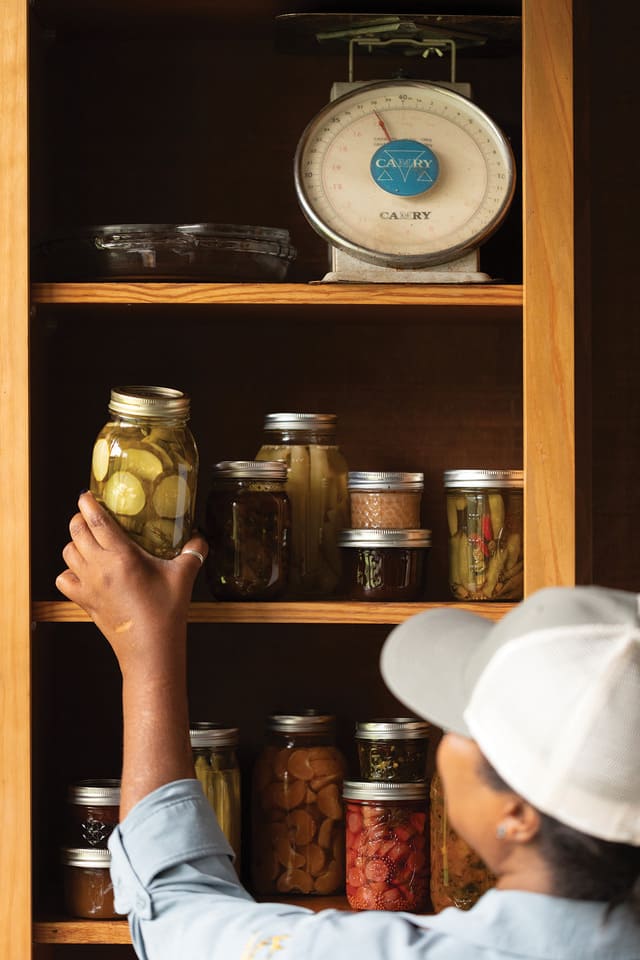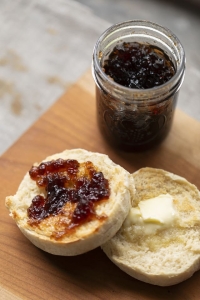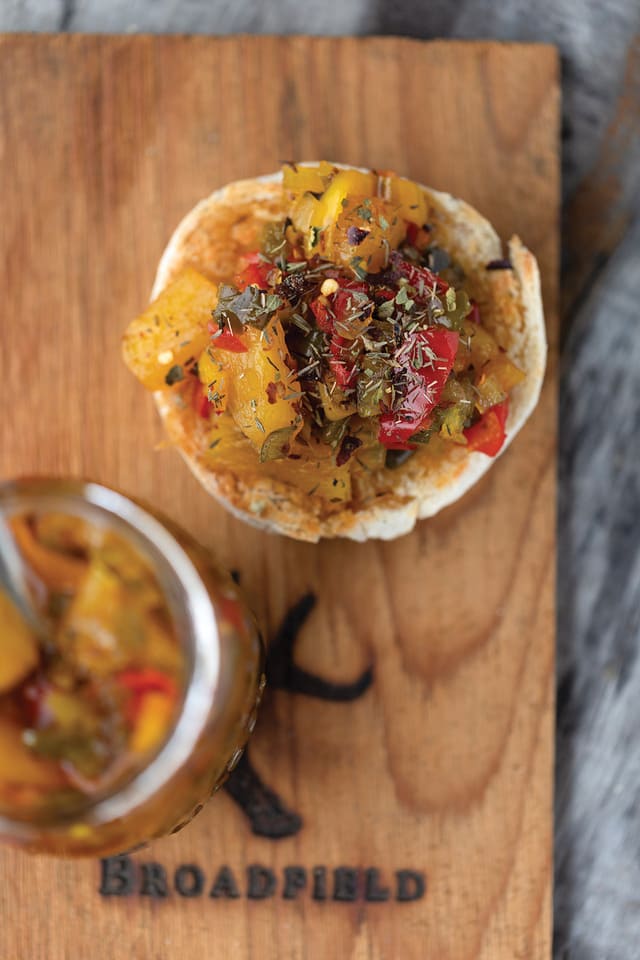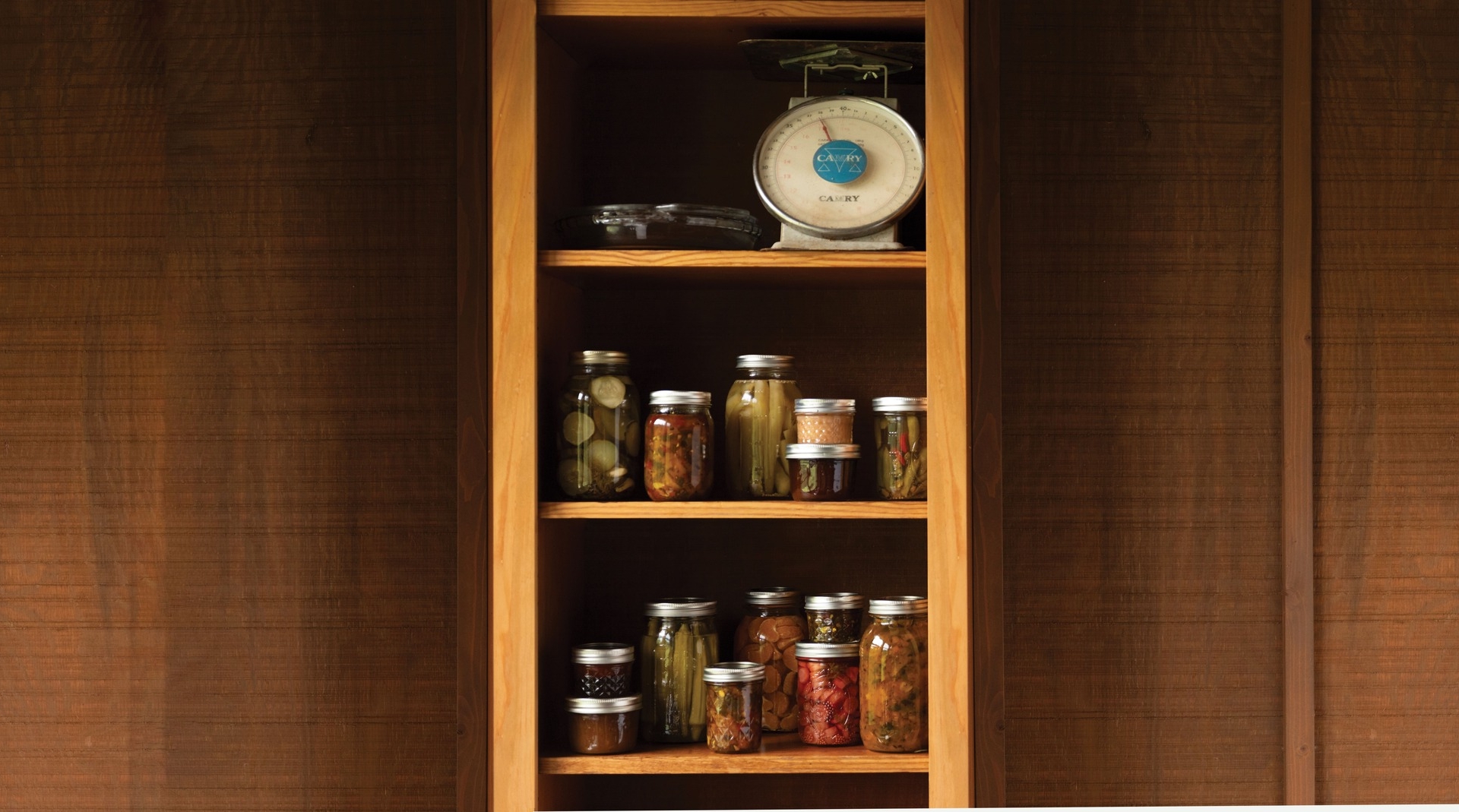Preserving Flavor
From sweet jams and jellies to savory chutneys, canned produce is back and better than ever.

Chef Paula Garrett creates delicious preserves for Broadfield guests.
Preserving fruit and vegetables started as a way to extend the life of produce and transformed into something delicious and versatile that can be found in homes and restaurants around the world. Canned produce not only lasts longer than fresh, it packs a nutritious punch, is minimally processed and adds depth of flavor and convenience.
The process of canning to preserve food, relying on sealing and heat sterilization, was invented back in the early 1800s in France and has been used ever since. In recent years, canning has gained popularity.
“Canning is an art that’s come back and is trending now, and it’s a good way to get people into gardening,” says Paula Garrett, chef de cuisine at Broadfield, A Sea Island Sporting Club and Lodge.
Garrett comes from a family that has preserved fruits and vegetables for as long as she can remember. “I was raised in southern Illinois,” she recalls. “Growing up, we canned everything.” Living on a farm, her family canned the produce that grew in the garden and sometimes meat as well.
Now, she has turned these childhood lessons into a skill that benefits diners at Broadfield, where she cans produce, pickles vegetables and creates sweet jams and jellies, chutneys, barbecue sauces and more.
 Much of the produce she uses comes from the Broadfield garden. Once she learns what will soon be ready for harvest, she starts planning whether it will be blanched and frozen, canned or made into a brine, marinade, sauce or preserved in olive oil. Her vast knowledge of these techniques allows her to make use of everything and ensure nothing goes to waste.
Much of the produce she uses comes from the Broadfield garden. Once she learns what will soon be ready for harvest, she starts planning whether it will be blanched and frozen, canned or made into a brine, marinade, sauce or preserved in olive oil. Her vast knowledge of these techniques allows her to make use of everything and ensure nothing goes to waste.
“I love the creative side of it,” Garrett comments. “Being able to create something with fresh ingredients and the fact that people delight in it — I think that, to me, is the best part.”
One of her most popular creations is a pineapple-jalapeño chutney that is served with Southern quail at Broadfield; it is also sometimes layered over brie on charcuterie boards. Other favorites include Garrett’s hot honey, blackberry jams and jellies, black and blue barbecue sauce, mayhaw jelly, chowchow and pickled peppers, though she also incorporates wild blueberries, pears and figs into her creations.
Many of the jellies are served during breakfast at Broadfield, but are also available for guests to purchase and take home. This makes them especially desirable, as they’re able to use them in their own at-home creations after enjoying them with meals around the table.
With all of the benefits that canning offers, it’s no surprise that it’s a pivotal part of the Sea Island culinary tapestry — and it enhances the taste of the dishes even more, knowing that they feature fresh, local and homegrown ingredients. Paula Garrett, chef de cuisine at Broadfield, A Sea Island Sporting Club and Lodge, shares her recipe for pineapple- jalapeño chutney, which can be served over a variety of dishes, including quail, baked brie, pork, and fish or veggie tacos.
PINEAPPLE-JALAPEÑO CHUTNEY
Paula Garrett, chef de cuisine at Broadfield, A Sea Island Sporting Club and Lodge, shares her recipe for pineapple-jalapeño chutney, which can be served over a variety of dishes, including quail, baked brie, pork, and fish or veggie tacos.
INGREDIENTS (YIELDS 6, 8-OUNCE JARS): 
- 6 cups fresh pineapple, chopped
- 1-1/2 cups sweet onion, finely chopped
- 2 cups chopped, seeded jalapeños
- 1 cup red bell pepper, finely chopped
- 1/2 cup green bell pepper, finely chopped
- 2 cloves garlic, minced
- 1-3/4 cups granulated sugar
- 1-1/2 teaspoons pickling or canning salt
- 1/4 teaspoon hot pepper flakes
- 1 cup white vinegar
- 1/2 cup rice vinegar
- 3 bay leaves
- 1 tablespoon dried thyme
- 1 tablespoon dried oregano
- 1 tablespoon dried ginger powder
- 1/4 teaspoon curry
- 1/4 teaspoon turmeric
DIRECTIONS: In a Dutch oven or large pot, bring all ingredients to a boil over medium heat, stirring often. Reduce heat and boil gently, stirring occasionally, for 25 minutes or until pineapple is translucent and mixture is thick enough to coat a spoon. Ladle into sterilized jars to within ½ inch of rim. Remove air pockets and adjust headspace if necessary by adding hot chutney. Wipe rims, then apply prepared lids and rings. Tighten rings until tight. Process jars in a boiling water canner for 10 minutes. Turn off canner and remove lid. Let jars stand in water for 5 minutes. Using canning tongs, transfer jars to a towel-lined surface and let rest at room temperature until cooled, then check seals. Refrigerate any unsealed jars for up to 3 weeks.




